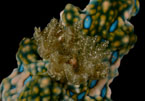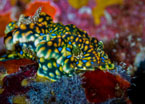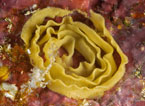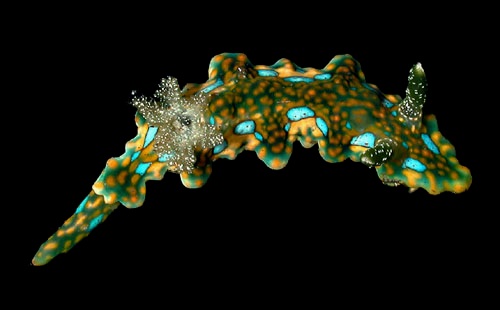| Home |
| Acknowledgments |
| Conventions |
| Glossary |
| Maps |
| References |
| Links |
| Articles |
| Thumbnails |
| Species
list |
| Family |
| Next
species |
Additional Photos

side

underside

rhinophore detail

branchia

small blue spots

large cream spots

violet

young

feeding

probable egg mass

Miamira sinuata (van Hasselt, 1824)

| Maximum size: 53 mm. Identification: This species usually has a bright green body with yellow to orange spots. However, occasional animals may have a predominantly violet body. Irregular bright blue spots, sometimes ringed in brown, encircle the notum just inside the mantle edge. The greenish rhinophores and translucent tan to violet gills are finely flecked with white. An unusual characteristic of this species is the tri-lobed anterior end of the mantle, with the middle lobe longer than the other two, almost giving it the appearance of having a “nose.” (Note 1) Natural history: Miamira sinuata is moderately rare in Hawaii (perhaps, increasing in recent years?). It has been recorded from tide pools and to a depth of 27 m (88 ft) in moderately exposed to exposed rocky habitats. The anterior and lateral mantle lobes may contain concentrations of glands that produce chemicals known to repel predators. It feeds on a red sponge with a gray-violet interior and lays a yellow, ruffled egg mass. (Note 2) Distribution: Big Island, Maui, Molokai, Oahu and Midway: widely distributed in the Indo-Pacific. Taxonomic notes: Miamira sinuata is listed in Bertsch and Johnson, 1981 as the "jolly green giant" and was first recorded in Hawaii from Waialua, Oahu by Scott Johnson on June 10, 1978. It's listed as Ceratosoma sinuata and referred to as the "jolly green giant" in Hoover, 1998 & 2006 (corrected in 2019 printing). (Note 3) Photo: CP: Napili Bay, Maui; May 1, 2003. Observations and comments: Note 1: The blue spots on a gold background aren't as precisely matched to the blue and gold ocelli found in the sea hares Stylocheilus striatus and Phycophila euchlora as are the markings in some other possible mimics. But, perhaps they are close enough so that M. sinuata is still deriving some benefit from the resemblance (since the sea hares are known to concentrate toxins from the cyanobacteria they eat)? Note 2: Probable egg masses found by Alexia Benrezkellah in 2021 in association with a pair of violet animals have a lower ribbon and somewhat larger eggs (proportionately) than egg masses associated with M. sinuata (and other Miamira spp) elsewhere in the Indo-Pacific. Perhaps, these characters change with age? Or, the Hawaiian population differs from the populations found elsewhere? Note 3: The presence of two distinct types of blue spotting in the Indo-Pacific population suggests that the species might be split in the future (only one is present in Hawaii). |
| Thumbnails |
Species
list |
Family | Next species | Top |